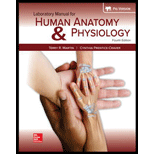
Laboratory Manual For Human Anatomy & Physiology
4th Edition
ISBN: 9781260159363
Author: Martin, Terry R., Prentice-craver, Cynthia
Publisher: McGraw-Hill Publishing Co.
expand_more
expand_more
format_list_bulleted
Concept explainers
Textbook Question
Chapter 5, Problem 4.9A
Electron micrographs represent extremely thin slices of cells. Each micrograph in figure 5.5 contains a section of a nucleus and some cytoplasm. Compare the organelles shown in these micrographs with organelles of the animal cell model and figure 5.1.
Using the terms provided, identify the structures indicated by the arrows in figure 5.5.
9. ________________________________
Expert Solution & Answer
Trending nowThis is a popular solution!

Students have asked these similar questions
State the five functions of Globular Proteins, and give an example of a protein for each function.
Diagram of check cell under low power and high power
a couple in which the father has the a blood type and the mother has the o blood type produce an offspring with the o blood type, how does this happen? how could two functionally O parents produce an offspring that has the a blood type?
Chapter 5 Solutions
Laboratory Manual For Human Anatomy & Physiology
Ch. 5 - Which of the following cellular structures is not...Ch. 5 - Which of the following cellular structures is...Ch. 5 - The outer boundary of a cell is the mitochondrial...Ch. 5 - Microtubules, intermediate filaments, and...Ch. 5 - Easily attainable living cells observed in this...Ch. 5 - A slide of human cheek cells can be stained to...Ch. 5 - Cellular energy is stored in ER. ATP. DNA. RNA.Ch. 5 - The smooth ER possesses ribosomes. True...Ch. 5 - The nuclear envelope contains nuclear pores. True...Ch. 5 - The cells lining the inside of the cheek are...
Ch. 5 - Figure 5.4 Label the indicated cellular structure...Ch. 5 - Match the cellular components in column A with the...Ch. 5 - Prob. 2.1ACh. 5 - Prob. 2.2ACh. 5 - What do the various types of cells in these...Ch. 5 - What are the main differences you observed among...Ch. 5 - Prob. 3.4ACh. 5 - Electron micrographs represent extremely thin...Ch. 5 - Electron micrographs represent extremely thin...Ch. 5 - Electron micrographs represent extremely thin...Ch. 5 - Electron micrographs represent extremely thin...Ch. 5 - Electron micrographs represent extremely thin...Ch. 5 - Electron micrographs represent extremely thin...Ch. 5 - Electron micrographs represent extremely thin...Ch. 5 - Electron micrographs represent extremely thin...Ch. 5 - Electron micrographs represent extremely thin...Ch. 5 - Electron micrographs represent extremely thin...
Knowledge Booster
Learn more about
Need a deep-dive on the concept behind this application? Look no further. Learn more about this topic, biology and related others by exploring similar questions and additional content below.Similar questions
- What is the opening indicated by the pointer? (leaf x.s.) stomate guard cell lenticel intercellular space none of thesearrow_forwardIdentify the indicated tissue? (stem x.s.) parenchyma collenchyma sclerenchyma ○ xylem ○ phloem none of thesearrow_forwardWhere did this structure originate from? (Salix branch root) epidermis cortex endodermis pericycle vascular cylinderarrow_forward
- Identify the indicated tissue. (Tilia stem x.s.) parenchyma collenchyma sclerenchyma xylem phloem none of thesearrow_forwardIdentify the indicated structure. (Cucurbita stem l.s.) pit lenticel stomate tendril none of thesearrow_forwardIdentify the specific cell? (Zebrina leaf peel) vessel element sieve element companion cell tracheid guard cell subsidiary cell none of thesearrow_forward
- What type of cells flank the opening on either side? (leaf x.s.) vessel elements sieve elements companion cells tracheids guard cells none of thesearrow_forwardWhat specific cell is indicated. (Cucurbita stem I.s.) vessel element sieve element O companion cell tracheid guard cell none of thesearrow_forwardWhat specific cell is indicated? (Aristolochia stem x.s.) vessel element sieve element ○ companion cell O O O O O tracheid O guard cell none of thesearrow_forward
- Identify the tissue. parenchyma collenchyma sclerenchyma ○ xylem O phloem O none of thesearrow_forwardPlease answer q3arrow_forwardRespond to the following in a minimum of 175 words: How might CRISPR-Cas 9 be used in research or, eventually, therapeutically in patients? What are some potential ethical issues associated with using this technology? Do the advantages of using this technology outweigh the disadvantages (or vice versa)? Explain your position.arrow_forward
arrow_back_ios
SEE MORE QUESTIONS
arrow_forward_ios
Recommended textbooks for you
 Human Physiology: From Cells to Systems (MindTap ...BiologyISBN:9781285866932Author:Lauralee SherwoodPublisher:Cengage Learning
Human Physiology: From Cells to Systems (MindTap ...BiologyISBN:9781285866932Author:Lauralee SherwoodPublisher:Cengage Learning


Human Physiology: From Cells to Systems (MindTap ...
Biology
ISBN:9781285866932
Author:Lauralee Sherwood
Publisher:Cengage Learning




Genome Annotation, Sequence Conventions and Reading Frames; Author: Loren Launen;https://www.youtube.com/watch?v=MWvYgGyqVys;License: Standard Youtube License